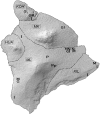Incipient radiation within the dominant Hawaiian tree Metrosideros polymorpha
- PMID: 24824285
- PMCID: PMC4181069
- DOI: 10.1038/hdy.2014.47
Incipient radiation within the dominant Hawaiian tree Metrosideros polymorpha
Abstract
Although trees comprise a primary component of terrestrial species richness, the drivers and temporal scale of divergence in trees remain poorly understood. We examined the landscape-dominant tree, Metrosideros polymorpha, for variation at nine microsatellite loci across 23 populations on young Hawai'i Island, sampling each of the island's five varieties throughout its full geographic range. For four varieties, principal coordinate analysis revealed strong clustering of populations by variety across the 10 430 km(2) island, indicating partitioning of the species into multiple evolutionarily significant units. The single island-endemic form, riparian var. newellii, showed especially strong differentiation from other varieties despite occurring in sympatry with other varieties and likely evolved from a bog form on the oldest volcano, Kohala, within the past 500 000 years. Along with comparable riparian forms on other Pacific Islands, var. newellii appears to represent parallel incipient ecological speciation within Metrosideros. Greater genetic distance among the more common varieties on the oldest volcano and an inverse relationship between allelic diversity and substrate age appear consistent with colonization of Hawai'i Island by older, partially diverged varieties followed by increased hybridization among varieties on younger volcanoes. This study demonstrates that broad population-level sampling is required to uncover patterns of diversification within a ubiquitous and long-lived tree species. Hawaiian Metrosideros appears to be a case of incipient radiation in trees and thus should be useful for studies of divergence and the evolution of reproductive isolating barriers at the early stages of speciation.
Figures





Similar articles
-
Divergent Selection and Primary Gene Flow Shape Incipient Speciation of a Riparian Tree on Hawaii Island.Mol Biol Evol. 2020 Mar 1;37(3):695-710. doi: 10.1093/molbev/msz259. Mol Biol Evol. 2020. PMID: 31693149 Free PMC article.
-
Divergence within and among 3 varieties of the endemic tree, 'Ohi'a Lehua (Metrosideros polymorpha) on the eastern slope of Hawai'i Island.J Hered. 2013 Jul-Aug;104(4):449-58. doi: 10.1093/jhered/est027. Epub 2013 May 2. J Hered. 2013. PMID: 23640992
-
Varieties of the highly dispersible and hypervariable tree, Metrosideros polymorpha, differ in response to mechanical stress and light across a sharp ecotone.Am J Bot. 2019 Aug;106(8):1106-1115. doi: 10.1002/ajb2.1331. Epub 2019 Jul 22. Am J Bot. 2019. PMID: 31330066
-
Speciation and phylogeography of Hawaiian terrestrial arthropods.Mol Ecol. 1998 Apr;7(4):519-31. doi: 10.1046/j.1365-294x.1998.00309.x. Mol Ecol. 1998. PMID: 9628003 Review.
-
Molecular biogeography and diversification of the endemic terrestrial fauna of the Hawaiian Islands.Philos Trans R Soc Lond B Biol Sci. 2008 Oct 27;363(1508):3363-76. doi: 10.1098/rstb.2008.0061. Philos Trans R Soc Lond B Biol Sci. 2008. PMID: 18765363 Free PMC article. Review.
Cited by
-
The paradox behind the pattern of rapid adaptive radiation: how can the speciation process sustain itself through an early burst?Annu Rev Ecol Evol Syst. 2019 Nov;50(1):569-593. doi: 10.1146/annurev-ecolsys-110617-062443. Epub 2019 Oct 1. Annu Rev Ecol Evol Syst. 2019. PMID: 36237480 Free PMC article.
-
Comparing Adaptive Radiations Across Space, Time, and Taxa.J Hered. 2020 Feb 5;111(1):1-20. doi: 10.1093/jhered/esz064. J Hered. 2020. PMID: 31958131 Free PMC article.
-
Foliar functional and genetic variation in a keystone Hawaiian tree species estimated through spectroscopy.Oecologia. 2023 May;202(1):15-28. doi: 10.1007/s00442-023-05374-1. Epub 2023 May 12. Oecologia. 2023. PMID: 37171625 Free PMC article.
-
Ancestral polymorphisms shape the adaptive radiation of Metrosideros across the Hawaiian Islands.Proc Natl Acad Sci U S A. 2021 Sep 14;118(37):e2023801118. doi: 10.1073/pnas.2023801118. Proc Natl Acad Sci U S A. 2021. PMID: 34497122 Free PMC article.
-
A quantitative analysis of phenotypic variations of Metrosideros polymorpha within and across populations along environmental gradients on Mauna Loa, Hawaii.Oecologia. 2016 Apr;180(4):1049-59. doi: 10.1007/s00442-015-3416-1. Epub 2015 Aug 11. Oecologia. 2016. PMID: 26260167
References
-
- Baldwin BG.1997Adaptive radiation of the Hawaiian silversword alliance: congruence and conflict of phylogenetic evidence from molecular and non-molecular investigationsIn: Givnish TJ, Sytsma KJ, (eds)Molecular evolution and adaptive radiation Cambridge Univ. Press: Cambridge, UK; 103–128.
-
- Calvo RN, Horvitz CC. Pollinator limitation, cost of reproduction, and fitness in plants: a transition-matrix demographic approach. Am Nat. 1990;136:499–516.
-
- Chybicki IJ, Burczyk J. Simultaneous estimation of null alleles and inbreeding coefficients. J Hered. 2009;100:106–113. - PubMed
-
- Cordell S, Goldstein G, Mueller-Dombois D, Webb D, Vitousek PM. Physiological and morphological variation in Metrosideros polymorpha, a dominant Hawaiian tree species, along an altitudinal gradient: the role of phenotypic plasticity. Oecologia. 1998;113:188–196. - PubMed
-
- Corn CA.1979. Variation in Hawaiian Metrosideros. PhD Dissertation. University of Hawai'i Manoa.
Publication types
MeSH terms
LinkOut - more resources
Full Text Sources
Other Literature Sources
Miscellaneous

